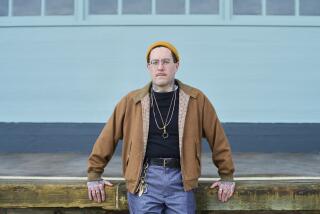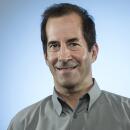O.C. Devotee of Shroud of Turin Puts History, Research on Display
- Share via
Some men have hobbies. Others have obsessions. And with enough money, an obsession can turn into a museum and let the whole world in for a peek. Which is why on the second floor of a nondescript office building in Fountain Valley, sandwiched between bicycle shops, sits the Shroud Center of Southern California.
The name doesn’t do it justice. It misses the point, and the sign probably wouldn’t pull in anyone off the street. What’s the big deal about shrouds?
But mention the Shroud of Turin, and eyes widen, and interest is piqued. Is it, as some of the faithful claim, Jesus’ burial cloth with an imprint of him made during the Resurrection? Or is it an elaborate fake from the Middle Ages?
Dr. August Accetta, the founder and director of the center, stands on the side of divinity.
Accetta has plowed hundreds of thousands of dollars into the museum and has written four papers on the shroud.
His dismay is obvious when he tells of three preachers who during Easter sermons spoke of Jesus’ rising from the dead but didn’t mention the Shroud of Turin.
Believers say the shroud, a piece of linen 14 feet, 3 inches by 3 feet, 7 inches -- or the more biblical two cubits by eight cubits -- shows a bearded man with markings that correspond to Jesus’ injuries: wounds on his head, stigmata on his wrist and feet, and a severe wound on his right side.
Accetta uses a phrase coined by a physicist colleague to explain how the image got onto the cloth. He calls it a “mechanical transparency.” Accetta says the body changed into “organized energy,” and at the moment of Resurrection, the shroud fell through what was the body, picking up the energy that corresponds to the body.
Others offer a simpler answer: It’s a fraud. And it wouldn’t be the first time a religious relic was exposed as fake.
The shroud is generally thought to have first appeared in the 14th century when Geoffrey de Charney, a French knight, returned with it from the Crusades.
About 40 years later, a French bishop became the first of many religious officials, including a pope, to declare the shroud a fake. It was during a period when many people claimed to have unearthed religious relics, such as pieces of the original cross and bones of the disciples.
Just last year the Israeli Antiquities Authority said that a box that supposedly held the bones of “James ... brother of Jesus” was phony.
The debate over the shroud appeared to have come to an end in 1988 after small pieces of it were subjected to sophisticated radiocarbon tests that determined it had originated between 1260 and 1390.
But like the debate over who killed President Kennedy, claims about the Shroud of Turin never go away.
Accetta will argue that the radiocarbon dating is wrong; how pollens found in the shroud are not found in Europe but in Jerusalem; and how a protective cloth was removed from the back of the shroud, showing another image of a man, not from the back, as one might expect, but from the front.
He says the image penetrates one human-hair width into the shroud on both sides and that the blood type has been identified as AB.
No scientist, he says, has been able to duplicate the image.
He traces the shroud back long before the 14th century, starting with a legend that the disciple Thaddeus brought it to Edessa, currently the Turkish city Urfa, where it was hidden and then discovered after a flood.
“I’ve read Edessan archives,” Accetta said. “I have them on CD ROM” translated into English. Coincidentally, his brother-in-law owns a house there.
The three-room center is at 8840 Warner Ave., on the second floor, and is open Saturdays and Sundays from 1 to 4 p.m. Admission is $8 for adults and $3 for children 12 or younger.
The rooms are filled with photos of the shroud, some 8 feet tall, including the most famous photo, taken in 1931 and which cost Accetta $2,000. There is a lance and a 6-inch crucifixion nail from Roman times.
Accetta, 44, became interested in the shroud as a teenager. He went to college and medical school, becoming a surgical gynecologist. Around 1989, he heard about a shroud research center in North Carolina. After a visit there, he read everything he could find on the subject and began collecting documents, photos and other material.
He opened the Shroud Center in 1996.
Since then he has presented his research in France, Italy, Richmond, Va., and Dallas.
The shroud itself, owned by the church under the care of the archbishop of Turin, is kept in a casket in the Royal Chapel in Turin, Italy.
In 1998, when it was last exhibited -- behind glass -- for public viewing, Accetta was among a group of researchers who spent three hours looking at it.
More to Read
Sign up for Essential California
The most important California stories and recommendations in your inbox every morning.
You may occasionally receive promotional content from the Los Angeles Times.











